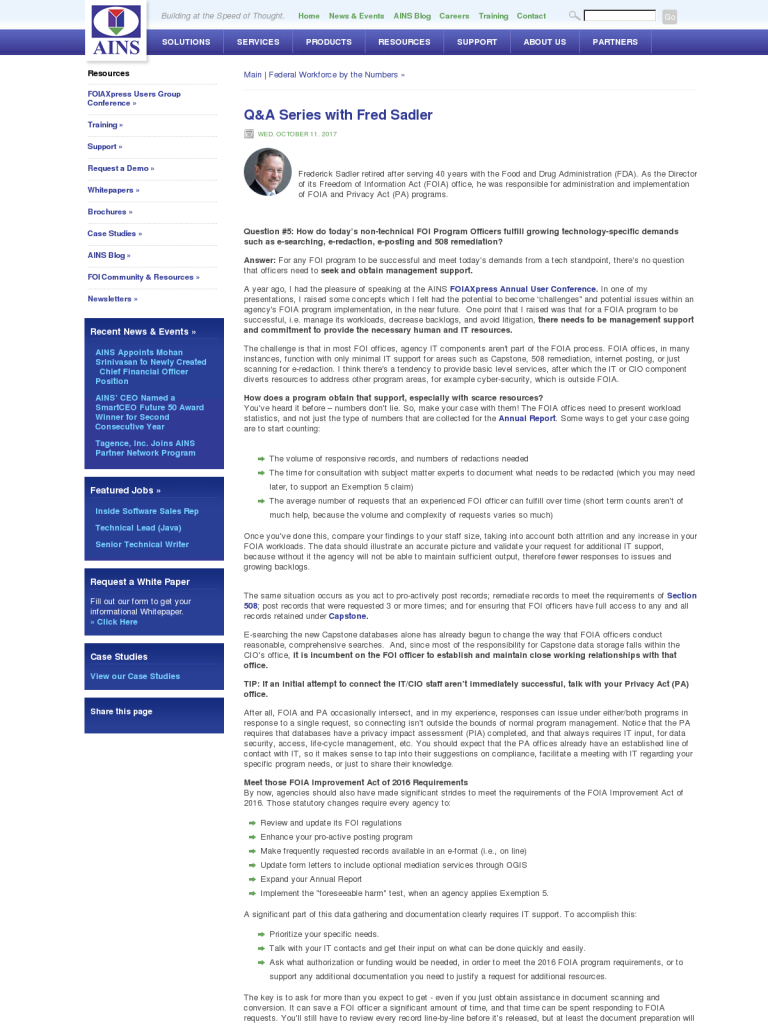Q&A Series with Fred Sadler
Blog: eCase Case Management Blog

Frederick Sadler retired after serving 40 years with the Food and Drug Administration (FDA). As the Director of its Freedom of Information Act (FOIA) office, he was responsible for administration and implementation of FOIA and Privacy Act (PA) programs.
Question #5: How do today’s non-technical FOI Program Officers fulfill growing technology-specific demands such as e-searching, e-redaction, e-posting and 508 remediation?
Answer: For any FOI program to be successful and meet today’s demands from a tech standpoint, there’s no question that officers need to seek and obtain management support.
A year ago, I had the pleasure of speaking at the AINS FOIAXpress Annual User Conference. In one of my presentations, I raised some concepts which I felt had the potential to become “challenges” and potential issues within an agency’s FOIA program implementation, in the near future. One point that I raised was that for a FOIA program to be successful, i.e. manage its workloads, decrease backlogs, and avoid litigation, there needs to be management support and commitment to provide the necessary human and IT resources.
The challenge is that in most FOI offices, agency IT components aren’t part of the FOIA process. FOIA offices, in many instances, function with only minimal IT support for areas such as Capstone, 508 remediation, internet posting, or just scanning for e-redaction. I think there’s a tendency to provide basic level services, after which the IT or CIO component diverts resources to address other program areas, for example cyber-security, which is outside FOIA.
- The volume of responsive records, and numbers of redactions needed
- The time for consultation with subject matter experts to document what needs to be redacted (which you may need later, to support an Exemption 5 claim)
- The average number of requests that an experienced FOI officer can fulfill over time (short term counts aren’t of much help, because the volume and complexity of requests varies so much)
The same situation occurs as you act to pro-actively post records; remediate records to meet the requirements of Section 508; post records that were requested 3 or more times; and for ensuring that FOI officers have full access to any and all records retained under Capstone.
E-searching the new Capstone databases alone has already begun to change the way that FOIA officers conduct reasonable, comprehensive searches. And, since most of the responsibility for Capstone data storage falls within the CIO’s office, it is incumbent on the FOI officer to establish and maintain close working relationships with that office.
TIP: If an initial attempt to connect the IT/CIO staff aren’t immediately successful, talk with your Privacy Act (PA) office.
After all, FOIA and PA occasionally intersect, and in my experience, responses can issue under either/both programs in response to a single request, so connecting isn’t outside the bounds of normal program management. Notice that the PA requires that databases have a privacy impact assessment (PIA) completed, and that always requires IT input, for data security, access, life-cycle management, etc. You should expect that the PA offices already have an established line of contact with IT, so it makes sense to tap into their suggestions on compliance, facilitate a meeting with IT regarding your specific program needs, or just to share their knowledge.
- Review and update its FOI regulations
- Enhance your pro-active posting program
- Make frequently requested records available in an e-format (i.e., on line)
- Update form letters to include optional mediation services through OGIS
- Expand your Annual Report
- Implement the “foreseeable harm” test, when an agency applies Exemption 5.
A significant part of this data gathering and documentation clearly requires IT support. To accomplish this:
- Prioritize your specific needs.
- Talk with your IT contacts and get their input on what can be done quickly and easily.
- Ask what authorization or funding would be needed, in order to meet the 2016 FOIA program requirements, or to support any additional documentation you need to justify a request for additional resources.
The key is to ask for more than you expect to get – even if you just obtain assistance in document scanning and conversion. It can save a FOI officer a significant amount of time, and that time can be spent responding to FOIA requests. You’ll still have to review every record line-by-line before it’s released, but at least the document preparation will have been done for you, and that will also simplify compliance with the posting requirements.
Are you being asked to do more with the FOI program, but don’t know enough about technology to know what needs to be done, or how to do it?
Share your experience here and Fred will address your challenge with a possible solution.
Leave a Comment
You must be logged in to post a comment.








